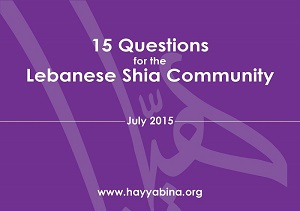 |
Considering the litany of roles Hezbollah plays on the Lebanese landscape, gathering the opinions of Lebanese Shia seemed particularly unnecessary to many domestic actors and foreign observers. After all, Hezbollah and the Lebanese Shia community appeared to be synonymous. Yet while the ability to take such measurements gained importance at certain periods in Lebanon’s recent history, hard data was virtually unavailable. In fact, the most dependable metrics were little more than guesstimates of the extent to which the Lebanese Shia community was supporting Hezbollah's choices. In reality, however, the Lebanese Shia community is no less quantifiable than any other.
In 2013, Hayya Bina oversaw the first public opinion poll to focus on Lebanese Shia. The survey was conducted in Dahiyeh, which is home to the largest aggregation of Shia in Lebanon, the members of which hail from various regions throughout the country and represent the entire spectrum of social classes. Then, in 2014, the organization conducted a second poll in Dahiyeh.
In its 2015 effort, however, Hayya Bina decided to broaden the poll to produce an open and quantitative understanding of Lebanon's Shia community—which is an essential precondition for understanding the prevailing Lebanese situation. Therefore, this latest product of Hayya Bina's research includes the far broader expanse of Lebanon’s "Shialand." Sample size was obviously adjusted, and the range of questions was extended to reflect recent domestic and regional developments.
In margin of the result presentation ShiaWatch suggests several "reading hints" obtained by cross-comparing some of the results and drawing attention to parallel responses. Of course, these are intended simply as ideas meant to stimulate debate.
Consider the following:
• 81.3% of Lebanon's Shia think things are moving in the wrong direction
• 43% consider themselves observant, among whom, 33% follow Khamenei’s religious views (including Wilayat al-Faqih) and others follow religious pundits (Marja’) who do not believe in that political-theological theory (Fadlallah)
• 66% believe their financial situation is worse than it was last year
• 86% consider the country’s economic situation worse than it was last year
• 52.8% think the Taif Agreement is no longer relevant to Lebanon
• 57.2% consider the takfiri threat the most important issue facing the community
• 55.6% think the South is safer than Dahiyeh or the Bekaa
• 53.2% know someone from their neighborhood/village/family who was killed in Syria
• 78.7% support Hezbollah’s involvement in Syria
• 79.9% think Hezbollah’s actions in Syria make them feel more secure
• 61.5% say they trust a specific leader to provide a better future for their family (the top two are Hassan Nasrallah at 69.9% and Nabih Berri at 17.2%)
• 61.9% believe the Alawi in Syria, the Shia in Iraq and the Houthi in Yemen are fighting for the same cause
• 43% consider themselves observant, among whom, 33% follow Khamenei’s religious views (including Wilayat al-Faqih) and others follow religious pundits (Marja’) who do not believe in that political-theological theory (Fadlallah)
• 66% believe their financial situation is worse than it was last year
• 86% consider the country’s economic situation worse than it was last year
• 52.8% think the Taif Agreement is no longer relevant to Lebanon
• 57.2% consider the takfiri threat the most important issue facing the community
• 55.6% think the South is safer than Dahiyeh or the Bekaa
• 53.2% know someone from their neighborhood/village/family who was killed in Syria
• 78.7% support Hezbollah’s involvement in Syria
• 79.9% think Hezbollah’s actions in Syria make them feel more secure
• 61.5% say they trust a specific leader to provide a better future for their family (the top two are Hassan Nasrallah at 69.9% and Nabih Berri at 17.2%)
• 61.9% believe the Alawi in Syria, the Shia in Iraq and the Houthi in Yemen are fighting for the same cause

 Print
Print Share
Share